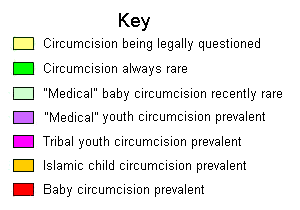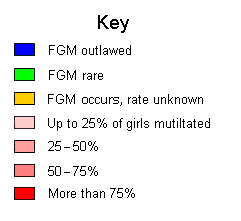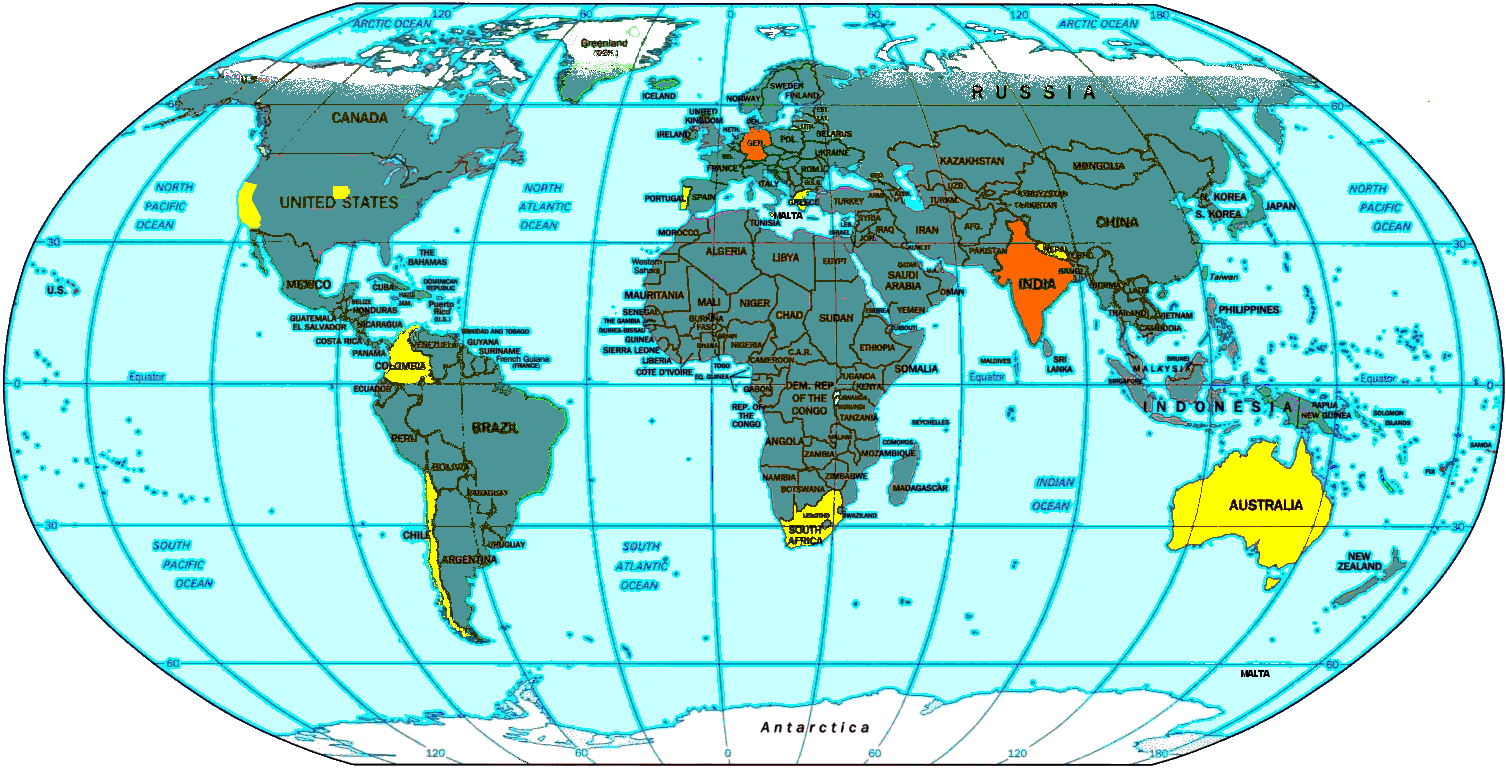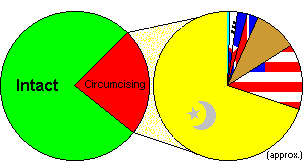Incidence and Distribution of Genital Cutting
Worldwide
|
||||||||||||||
|
Where Males Are and Are Not
Intact |
|
| Intact Virtually all: Chinese, Japanese, North Koreans, Vietnamese, Laotians, Cambodians, Burmese, Thais Hindus, Sikh, Parsee and Christian Indians Scandinavians Zulus, Shona, certain other African nations most Melanesian and some Western Polynesian (Rennell, Bellona) peoples, The great majority of: Europeans men of the former Soviet Union Central and South Americans New Zealand Maori Younger men of Britain and the Commonwealth, especially New Zealand and Australia About half of: Malaysians (Hindu and Christian Tamils, Chinese and Orang Asli) A significant minority of: Americans, especially younger, Hispanic, and in the South West Bangladeshis (20% are Hindu) |
Cut About 500,000,000 Muslims More than 100,000,000 USAmericans About 25,000,000 Filipinos Some tens of millions of older men of Britain and the Commonwealth Some tens of millions of African tribesmen About 14,000,000 South Koreans 7,000,000 Jews Some hundreds of thousands of Central and Eastern Polynesians (Samoa, Tahiti, Tonga, Niue, Tokelau) and Melanesians (Fiji, Vanuatu, parts of Solomon Islands and small parts of PNG) Some thousands of aboriginal Australians, mainly in the north and west |

Click on the map for a larger image.
 Of necessity, this map generalises. In South Africa, for example, whites of British extraction (but not Afrikaners) circumcised "medically" until recently, Xhosa circumcise tribally and Zulus had stopped circumcising but have recently resumed. Even in Israel (barely visible even on the larger map), surprisingly many parents leave their sons intact. |
Iceland
In January 2018, Silja Dögg Gunnarsdóttir of the Progressive Party, which is in the government coalition, presented a Bill to allow the genital cutting of boys only where it is necessary to protect their health. It was strongly opposed by Muslim and Jewish organisations. Circumsision is not yet legally questioned, but on April 26, 2010, the KNMG (Royal Dutch Medical Association) issued a policy urging its members not to perform it. This decision is believed to be the first of its kind in any country. As an immediate result, the consent of both parents
is now required. |
Incidence and Distribution of Female Genital Cutting Worldwide

Click on the map for a larger image.
 (FGC is outlawed in countries marked with blue crosshatching but is still prevalent at the rate shown in the underlying shade of pink.) |
FGC is outlawed in the USA, but for a month in 2010, the American Academy of Pediatrics policy suggested doctors be allowed to perform a "ritual nick" to prevent worse. The policy was withdrawn after a storm of protest.
One striking conclusion from these two maps is that wherever Female Genital Cutting is prevalent, male circumcision is also (though the reverse is of course not the case).
People who object that there is no comparison between FGC and MGC should see the list of comparisons.
Status of Intersex Worldwide

Click on the map for a larger image.
 |
In most of the world, intersexed people are unrecognised and genital assignment surgery of intersexed babies is unregulated. The United Nations has not officially recognised Intersex people nor condemned gender-assignment surgery. It is mentioned erratically, if at all, at meetings of Human Rights bodies. |
|
Germany: An indeterminate sex, "X" is recognised, but this has not proved to be the boon that it has been touted, because it opens the door for Intersexed people to be regarded as having a "disorder" that must be "corrected". India: Intersex babies may be consigned to the class of hijra ("eunuchs") which also includes transgender, transsexual and castrated people. While recognised, they are a low caste who survive by singing univited at weddings, and by prostitution. |
|
|
Australia: The Sex Discrimination Amendment (Sexual Orientation, Gender Identity and Intersex Status) Bill 2013 provides protection against discrimination on the basis of intersex status. The State Goverment of Victoria has (July 2021) issued a position paper, "(i) Am Equal", setting out rights for people with Variations in Sex Characteristics, including "deferrable medical interventions modifying a person’s sex characteristics without personal consent" and "an oversight panel to ensure compliance with the prohibition". California, USA: August 2018, the State Legislature passed a resolution demanding the medical community halt nonconsensual medical procedures that try to cosmetically "normalize" variations in intersex children's sex characteristics. Chile: January 2017, Ministry of Health opposes “unnecessary ‘normalization’ treatments of intersex children” that include “irreversible genital surgeries until they are of a sufficient age to make decisions about their bodies.” Colombia: Sex assignment surgery (intersex genital mutilation, IGM) is banned Greece:
July
2022, Sex assignment surgery age-restricted to
15 and over with the person's consent. Iowa, USA: Bill introduced March 2019 to outlaw intersex surgery on minors Malta: In April 2015, outlawed medical practitioners or other professionals from conducting any involuntary or coerced surgical intervention on minors with intersex variations. Nepal: A 2007 case, Pant v. Nepal resulted in Writ No. 917 in 2011, mandating that citizens be allowed to self-identify as a third gender on all official documents and registers. Portugal: May 2017, surgery on intersex babies outlawed. South Africa: Intersex people are protected from sex discrimination: "Sex" is defined to include intersex (defined as “a congenital sexual differentiation which is atypical, to whatever degree”) in the Judicial Matters Amendment Act, 2005 |
Updates and corrections welcome. You can email me.
Back to the Intactivism index page.
